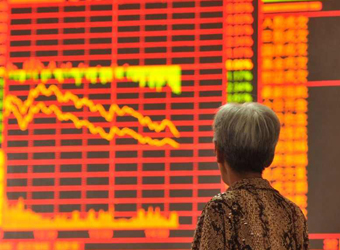Two summers passed after a major Chinese stock market crash, Monday’s stock tumble points to how much steadier the mainland markets have become.
Nearly 500 stocks on the small-cap ChiNext index plunged before hitting the 10 percent lower limit, according to Reuters. The technology-heavy index dropped 5.1 percent to close at its lowest since Jan. 16, 2015, according to FactSet. Some news outlets deemed it a “Black Monday” for Chinese stocks.
However, broader indexes containing stocks of bigger companies fared relatively better. The Shanghai composite fell 1.4 percent, marking its worst day since Dec. 12, while the CSI 300 fell 1.1 percent in its worst day since June 14. Hong Kong’s Hang Seng index closed slightly higher.
It was enough to remind people how much markets have changed since the summer of 2015, when the Shanghai and Shenzhen stock indexes crashed more than 40 percent, resulting in hundreds of stock trading suspensions. Chinese regulators also heavily intervened in the stock market by preventing major shareholders from selling and reportedly creating a group of stock buyers to support the market.
In the year-and-a-half since, China has replaced its stock market regulator and emphasized financial market stability. Stock index company MSCI also gave the mainland stocks a vote of confidence in June when it announced some of the largest mainland stocks would join its benchmark emerging markets index. Disappointment from MSCI’s earlier rejection of those stocks in June 2015 also contributed to the market selloff that summer.
“This is nothing like in 2015 anymore. Back then, leadership was legitimately panicked,” said Chris Beddor, associate, Asia, for consulting firm Eurasia Group.
“Officials are not as concerned about market swings as they were given there’s less pronounced government intervention in the market,” he said. Beddor noted that voluntary trading suspensions and stock market intervention by the so-called national team exist on a much smaller level than two years ago.
The Chinese small-cap stocks’ sharp decline Monday followed weeks of underperformance since April, when Chinese authorities began to force banks to rein in off-balance-sheet lending, Beddor pointed out.
This past weekend, Chinese President Xi Jinping said at the National Financial Work Conference that regulators should strengthen supervision, according to CGTN, China’s international media outlet.
The financial work conference is held once every five years, and this weekend’s meeting comes ahead of a key National Communist Party Congress scheduled for the fall when Xi is expected to consolidate his power.
The ChiNext’s drop to 2015 lows “really is an indication of how seriously investors view the current financial clampdown and how vulnerable many of the firms listed on the ChiNext are to a deleveraging campaign,” he said. “Small-cap ChiNext stocks usually amplify broader movements in the market because they’re so highly leveraged.”
The ChiNext is down 15.6 percent year to date. In contrast, the Shanghai composite is up a muted 2.4 percent, amid increased regulatory scrutiny on firms’ financial practices.
The Chinese tech stocks also fell after Leshi Internet Information & Technology said Friday it expects to post a net loss of between 636.7 million yuan ($94 million) and 641.7 million yuan for the first half of the calendar year, compared to a net profit of 284.4 million yuan a year earlier.
“Maybe some concern, smaller-cap names might not be able to meet high expectations,” said Brendan Ahern, chief investment officer of KraneShares, which sells exchange-traded funds for Chinese stocks.
Analysts also noted worries that regulators would allow more initial public offerings, potentially taking away buying demand from the small-cap tech stocks.
Meanwhile, China’s 10-year government bond yield held higher, near 3.56 percent. On Monday, the world’s second-largest economy reported second-quarter GDP growth of 6.9 percent, slightly better than expectations.
Source: CNBC & Reuters
